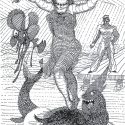Elsa Gress established together with her American husband, the painter Clifford Wright, a collective cultural centre for art, literature, theatre, and film called Decenteret, where Danish and foreign artists met for many years. She grew up in an untraditional family that had suffered social decline. As an adolescent in the late 1930s, she went on walking tours through Nazi Germany and France, and by the time she sat her degree examination she had lived underground for a long period as an active resistance fighter. After the war, she was one of the first people to resurface in a Europe in ruins.
Elsa Gress made her debut in 1945 with the publication of her essay collection Strejftog. Among her most important works are the memoirs Mine mange hjem, 1965, Fuglefri og fremmed, 1971, and Compañia 1-2, 1976, in which she describes the feeling of asynchronicity, which went on to become an important theme in her literary works and which labelled her “a professional outsider”. In 1964, she published the debate book Det uopdagede køn, in which she criticises the prevailing “single-gender society” and emphasises humanism in preference to feminism. In many of her novels, short stories, and essays she is preoccupied with the role of the artist, such as in her last novels Salamander, 1977, and Simurghen, 1986. In Salamander, art is described as an uncompromising and at times painful calling, and in Simurghen, the creation of a painting is interwoven with death and loss.
Her writing also includes dramas and radio plays. Owing to her viewpoints, Elsa Gress is often classified as a cultural radical; however, over the years she became more of a cultural aristocrat. She remained a castigator of society, culture, and gender, who, with her heretical viewpoints, was referred to, among other things, as Denmark’s one and only “angry young man”. She became a member of Det Danske Akademi (the Danish academy of language and literature) in 1975.


